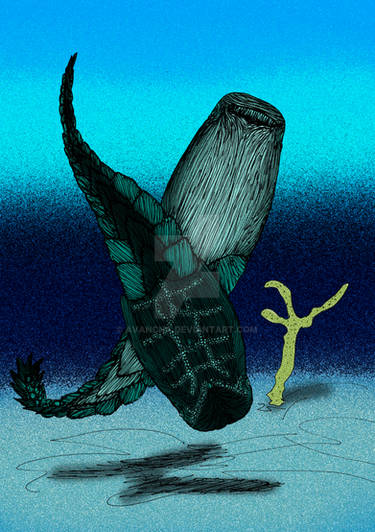ShopDreamUp AI ArtDreamUp
Deviation Actions
Suggested Deviants
Suggested Collections
You Might Like…
Featured in Groups
Description
Kingdom: Animalia
Phylum: Mollusca
Class: Cephalopoda
Order: Exipoda
Family: Balonikalamaria
Genus: Netchus
Species: N. starkus
Before Arceus' Eden, the biodiversity of Midgard's continents was much greater. Westeros and Tamriel in particular were host to a vast range of now extinct creatures. Netches suffered immensely with the arrival of Endoran species, such as deer, bears, wolves, boars, cats, and horses, in both continents and now only survive as a single species in the ashlands of Vvardenfell and the fungal plains of Deshaan.
The Winterfell netch was one of two known Westerosi netches to live in the Pleistocene, the other being the Dornish netch, and had a range stretching from the Neck to the Atmoran icecap. Like their living relatives, the Winterfell netch was primarily a filter feeder, living off airborne organic particles and supplementing that with vegetation, which it processed via a small beak. Unlike their relatives, the Coleoidea (squid and octopus), netches do not have proper eyes. Instead their leathery (pseudo-scale) hides, which are still highly prized for armour, were covered in light-sensitive cells. Netches also have hair-like integument growing out from under the front scales to detect vibrations and chemicals in the air. Much of their internal volume is taken up by large hydrogen sacs, modified ink sacs, which keep them afloat. By inflating and deflating sacs in different parts of the body, the netch can move. However, strong winds are troublesome for all netches. The Winterfell netch was much more compact than its living relatives, though the reason for this is unknown since its range covered the same latitudes as the living species inhabit.
Netches were venerated by the ancient children of the forest and featured prominently in their art. However both species in Westeros died out around 75,000 years ago, along with most of the native fauna, due to a change in the flora.
Phylum: Mollusca
Class: Cephalopoda
Order: Exipoda
Family: Balonikalamaria
Genus: Netchus
Species: N. starkus
Before Arceus' Eden, the biodiversity of Midgard's continents was much greater. Westeros and Tamriel in particular were host to a vast range of now extinct creatures. Netches suffered immensely with the arrival of Endoran species, such as deer, bears, wolves, boars, cats, and horses, in both continents and now only survive as a single species in the ashlands of Vvardenfell and the fungal plains of Deshaan.
The Winterfell netch was one of two known Westerosi netches to live in the Pleistocene, the other being the Dornish netch, and had a range stretching from the Neck to the Atmoran icecap. Like their living relatives, the Winterfell netch was primarily a filter feeder, living off airborne organic particles and supplementing that with vegetation, which it processed via a small beak. Unlike their relatives, the Coleoidea (squid and octopus), netches do not have proper eyes. Instead their leathery (pseudo-scale) hides, which are still highly prized for armour, were covered in light-sensitive cells. Netches also have hair-like integument growing out from under the front scales to detect vibrations and chemicals in the air. Much of their internal volume is taken up by large hydrogen sacs, modified ink sacs, which keep them afloat. By inflating and deflating sacs in different parts of the body, the netch can move. However, strong winds are troublesome for all netches. The Winterfell netch was much more compact than its living relatives, though the reason for this is unknown since its range covered the same latitudes as the living species inhabit.
Netches were venerated by the ancient children of the forest and featured prominently in their art. However both species in Westeros died out around 75,000 years ago, along with most of the native fauna, due to a change in the flora.
Image size
1624x1793px 2.95 MB
© 2014 - 2024 tomme23
Comments0
Join the community to add your comment. Already a deviant? Log In






![Midgard: A Fantasy World Map - [OLD VERSION]](https://images-wixmp-ed30a86b8c4ca887773594c2.wixmp.com/f/d92da121-122c-4f6e-8ff9-9b90874cdb51/d7hmho0-52a20719-7997-4848-9f88-5c92a47bed1b.png/v1/crop/w_92,h_92,x_7,y_0,scl_0.057934508816121,q_70,strp/midgard__a_fantasy_world_map____old_version__by_tomme23_d7hmho0-92s.jpg?token=eyJ0eXAiOiJKV1QiLCJhbGciOiJIUzI1NiJ9.eyJzdWIiOiJ1cm46YXBwOjdlMGQxODg5ODIyNjQzNzNhNWYwZDQxNWVhMGQyNmUwIiwiaXNzIjoidXJuOmFwcDo3ZTBkMTg4OTgyMjY0MzczYTVmMGQ0MTVlYTBkMjZlMCIsIm9iaiI6W1t7ImhlaWdodCI6Ijw9MTU4OCIsInBhdGgiOiJcL2ZcL2Q5MmRhMTIxLTEyMmMtNGY2ZS04ZmY5LTliOTA4NzRjZGI1MVwvZDdobWhvMC01MmEyMDcxOS03OTk3LTQ4NDgtOWY4OC01YzkyYTQ3YmVkMWIucG5nIiwid2lkdGgiOiI8PTIwNDMifV1dLCJhdWQiOlsidXJuOnNlcnZpY2U6aW1hZ2Uub3BlcmF0aW9ucyJdfQ.XbavUrSnWqhBWlZTc5qtcaunL1SEcv4Xt6rPEEsxxis)
![Midgard - Political Map, 5E 1 - [OLD VERSION]](https://images-wixmp-ed30a86b8c4ca887773594c2.wixmp.com/f/d92da121-122c-4f6e-8ff9-9b90874cdb51/d8wehlm-64b1329f-9744-4c98-b8a8-d156be7c9422.png/v1/crop/w_92,h_92,x_7,y_0,scl_0.019311502938707,q_70,strp/midgard___political_map__5e_1____old_version__by_tomme23_d8wehlm-92s.jpg?token=eyJ0eXAiOiJKV1QiLCJhbGciOiJIUzI1NiJ9.eyJzdWIiOiJ1cm46YXBwOjdlMGQxODg5ODIyNjQzNzNhNWYwZDQxNWVhMGQyNmUwIiwiaXNzIjoidXJuOmFwcDo3ZTBkMTg4OTgyMjY0MzczYTVmMGQ0MTVlYTBkMjZlMCIsIm9iaiI6W1t7ImhlaWdodCI6Ijw9NDc2NCIsInBhdGgiOiJcL2ZcL2Q5MmRhMTIxLTEyMmMtNGY2ZS04ZmY5LTliOTA4NzRjZGI1MVwvZDh3ZWhsbS02NGIxMzI5Zi05NzQ0LTRjOTgtYjhhOC1kMTU2YmU3Yzk0MjIucG5nIiwid2lkdGgiOiI8PTYxMjkifV1dLCJhdWQiOlsidXJuOnNlcnZpY2U6aW1hZ2Uub3BlcmF0aW9ucyJdfQ.WTzNYTKLvOfNk3jAuWdv35zO39ov8NNMxJQMPOUypWk)

![Midgard - Political Map, Hol 8 - [OLD VERSION]](https://images-wixmp-ed30a86b8c4ca887773594c2.wixmp.com/f/d92da121-122c-4f6e-8ff9-9b90874cdb51/d970day-d96b46d0-301d-4e36-aeb1-4640f64fc341.png/v1/crop/w_92,h_92,x_7,y_0,scl_0.019311502938707,q_70,strp/midgard___political_map__hol_8____old_version__by_tomme23_d970day-92s.jpg?token=eyJ0eXAiOiJKV1QiLCJhbGciOiJIUzI1NiJ9.eyJzdWIiOiJ1cm46YXBwOjdlMGQxODg5ODIyNjQzNzNhNWYwZDQxNWVhMGQyNmUwIiwiaXNzIjoidXJuOmFwcDo3ZTBkMTg4OTgyMjY0MzczYTVmMGQ0MTVlYTBkMjZlMCIsIm9iaiI6W1t7ImhlaWdodCI6Ijw9NDc2NCIsInBhdGgiOiJcL2ZcL2Q5MmRhMTIxLTEyMmMtNGY2ZS04ZmY5LTliOTA4NzRjZGI1MVwvZDk3MGRheS1kOTZiNDZkMC0zMDFkLTRlMzYtYWViMS00NjQwZjY0ZmMzNDEucG5nIiwid2lkdGgiOiI8PTYxMjkifV1dLCJhdWQiOlsidXJuOnNlcnZpY2U6aW1hZ2Uub3BlcmF0aW9ucyJdfQ.xFyi5SlRfTayRtISVgMRutGv25cX0Ip6Wb4QS3TAp5A)
![Midgard - Political Map, 3E 1 - [OLD VERSION]](https://images-wixmp-ed30a86b8c4ca887773594c2.wixmp.com/f/d92da121-122c-4f6e-8ff9-9b90874cdb51/d8xaz60-45973ba3-248a-429b-98e9-9a22edb2f915.png/v1/crop/w_92,h_92,x_7,y_0,scl_0.019311502938707,q_70,strp/midgard___political_map__3e_1____old_version__by_tomme23_d8xaz60-92s.jpg?token=eyJ0eXAiOiJKV1QiLCJhbGciOiJIUzI1NiJ9.eyJzdWIiOiJ1cm46YXBwOjdlMGQxODg5ODIyNjQzNzNhNWYwZDQxNWVhMGQyNmUwIiwiaXNzIjoidXJuOmFwcDo3ZTBkMTg4OTgyMjY0MzczYTVmMGQ0MTVlYTBkMjZlMCIsIm9iaiI6W1t7ImhlaWdodCI6Ijw9NDc2NCIsInBhdGgiOiJcL2ZcL2Q5MmRhMTIxLTEyMmMtNGY2ZS04ZmY5LTliOTA4NzRjZGI1MVwvZDh4YXo2MC00NTk3M2JhMy0yNDhhLTQyOWItOThlOS05YTIyZWRiMmY5MTUucG5nIiwid2lkdGgiOiI8PTYxMjkifV1dLCJhdWQiOlsidXJuOnNlcnZpY2U6aW1hZ2Uub3BlcmF0aW9ucyJdfQ.16V5tgwEmBSxZi7Os45UbNYNF-Pd7VQZr6IJATNxJ8o)























